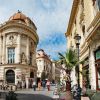The hidden world of insects, showcased in a macro photography exhibition at the “Antipa” Museum

By Bucharest Team
- Articles
The macro photography exhibition titled “The Face of the Beast. Perfection Lies in the Details” will be open from July 10 to August 31 at the “Grigore Antipa” National Museum of Natural History.
Signed by photographer Claudiu Mihai, The Face of the Beast reveals stunning details of insects – gem-like compound eyes, strong mandibles, delicate antennae – inviting the viewer to discover the hidden beauty of some of the smallest creatures on Earth.
In addition to the impressive image gallery, visitors are invited to take part in an interactive experience. By scanning a QR code, they can discover the species behind each portrait and learn more about the insects featured in the photographs.
The Face of the Beast is more than a photographic exploration – it’s an invitation to see nature with new eyes and to appreciate the hidden perfection in the smallest details.
The exhibition is curated by the photographer himself, Dr. Claudiu Mihai, and Dr. Luis Ovidiu Popa, manager of the “Grigore Antipa” Museum.
Dr. Claudiu Mihai is a family physician and a graduate of the Master’s program in Biophysics and Cellular Biotechnology at the “Carol Davila” University of Medicine and Pharmacy. Passionate about photography for over 15 years, he has recently focused on extreme macro photography, a genre at the crossroads of art and science.
Dr. Luis Ovidiu Popa, a senior scientific researcher, is also known for his educational initiatives that bring the public closer to the richness and beauty of the natural world.
The “Grigore Antipa” National Museum of Natural History is one of the most important museums in Romania and Eastern Europe, founded in 1834 by Mihalache Ghica, who donated valuable collections of coins, fossils, animals, and artworks. Since 1908, the museum has been housed in its current building, designed by Dr. Grigore Antipa, the visionary director who led the institution between 1893 and 1944 and introduced the world’s first biogeographical dioramas. Today, the museum holds a scientific heritage of approximately 2 million specimens, organized into collections of zoology, geology, paleontology, comparative anatomy, anthropology, and ethnography. With over 500,000 annual visitors, Antipa is a pillar of research, education, and biodiversity conservation.






























